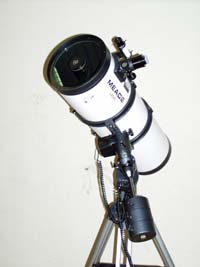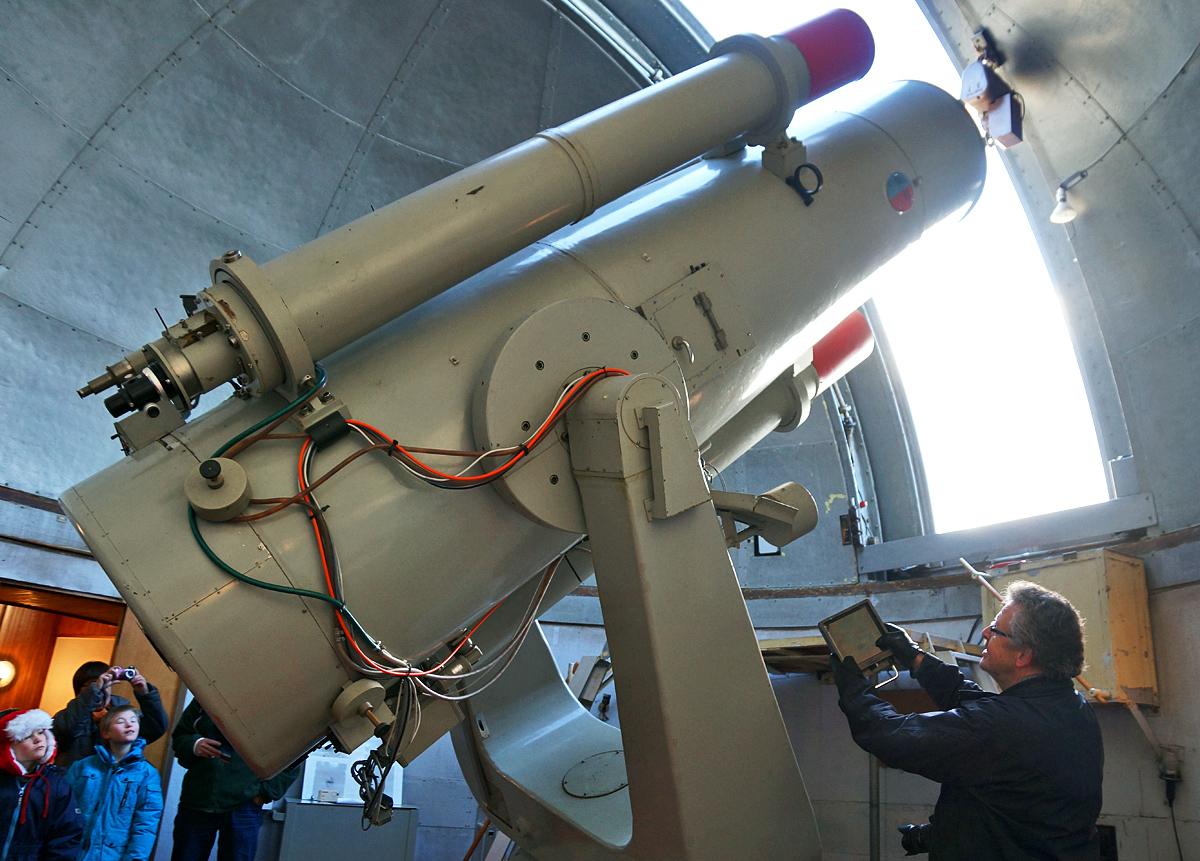|
Schmidt–Newtonian Telescope
A Schmidt–Newtonian telescope or Schmidt–Newton telescope is a catadioptric telescope that combines elements from both the Schmidt camera and the Newtonian telescope. In this telescope design, a spherical primary mirror is combined with a Schmidt corrector plate, which corrects the spherical aberration and holds the secondary mirror. The resulting system has less coma and diffraction effects than a Newtonian telescope with a parabolic mirror (which is free of spherical aberration but not free of coma) and a "spider" secondary mirror support. The design uses a 45° flat secondary mirror to view the image, as in a standard Newtonian telescope. Advantages Schmidt–Newtonian telescopes offer images with less coma A coma is a deep state of prolonged unconsciousness in which a person cannot be awakened, fails to respond normally to painful stimuli, light, or sound, lacks a normal wake-sleep cycle and does not initiate voluntary actions. Coma patients exhi ... than Ne ... [...More Info...] [...Related Items...] OR: [Wikipedia] [Google] [Baidu] |
Catadioptric System
A catadioptric optical system is one where refraction and reflection are combined in an optical system, usually via lenses (dioptrics) and curved mirrors (catoptrics). Catadioptric combinations are used in focusing systems such as searchlights, headlamps, early lighthouse focusing systems, optical telescopes, microscopes, and telephoto lenses. Other optical systems that use lenses and mirrors are also referred to as "catadioptric", such as surveillance catadioptric sensors. Early catadioptric systems Catadioptric combinations have been used for many early optical systems. In the 1820s, Augustin-Jean Fresnel developed several catadioptric lighthouse reflectors. Léon Foucault developed a catadioptric microscope in 1859 to counteract aberrations of using a lens to image objects at high power. In 1876 a French engineer, A. Mangin, invented what has come to be called the Mangin mirror, a concave glass reflector with the silver surface on the rear side of the glass. The two surfaces o ... [...More Info...] [...Related Items...] OR: [Wikipedia] [Google] [Baidu] |
Schmidt Camera
A Schmidt camera, also referred to as the Schmidt telescope, is a catadioptric astrophotographic telescope designed to provide wide fields of view with limited aberrations. The design was invented by Bernhard Schmidt in 1930. Some notable examples are the Samuel Oschin telescope (formerly Palomar Schmidt), the UK Schmidt Telescope and the ESO Schmidt; these provided the major source of all-sky photographic imaging from 1950 until 2000, when electronic detectors took over. A recent example is the Kepler space telescope exoplanet finder. Other related designs are the Wright camera and Lurie–Houghton telescope. Invention and design The Schmidt camera was invented by German–Estonian optician Bernhard Schmidt in 1930. Its optical components are an easy-to-make spherical primary mirror, and an aspherical correcting lens, known as a Schmidt corrector plate, located at the center of curvature of the primary mirror. The film or other detector is placed inside the camera, at the ... [...More Info...] [...Related Items...] OR: [Wikipedia] [Google] [Baidu] |
Newtonian Telescope
The Newtonian telescope, also called the Newtonian reflector or just a Newtonian, is a type of reflecting telescope invented by the English scientist Sir Isaac Newton, using a concave primary mirror and a flat diagonal secondary mirror. Newton's first reflecting telescope was completed in 1668 and is the earliest known functional reflecting telescope. The Newtonian telescope's simple design has made it very popular with amateur telescope makers. Description [...More Info...] [...Related Items...] OR: [Wikipedia] [Google] [Baidu] |
Spherical Mirror
A curved mirror is a mirror with a curved reflecting surface. The surface may be either ''convex'' (bulging outward) or ''concave'' (recessed inward). Most curved mirrors have surfaces that are shaped like part of a sphere, but other shapes are sometimes used in optical devices. The most common non-spherical type are parabolic reflectors, found in optical devices such as reflecting telescopes that need to image distant objects, since spherical mirror systems, like spherical lenses, suffer from spherical aberration. Distorting mirrors are used for entertainment. They have convex and concave regions that produce deliberately distorted images. They also provide highly magnified or highly diminished (smaller) images when the object is placed at certain distances. Convex mirrors A convex mirror or diverging mirror is a curved mirror in which the reflective surface bulges towards the light source. Convex mirrors reflect light outwards, therefore they are not used to focus light. Su ... [...More Info...] [...Related Items...] OR: [Wikipedia] [Google] [Baidu] |
Primary Mirror
A primary mirror (or primary) is the principal light-gathering surface (the objective) of a reflecting telescope. Description The primary mirror of a reflecting telescope is a spherical or parabolic shaped disks of polished reflective metal (speculum metal up to the mid 19th century), or in later telescopes, glass or other material coated with a reflective layer. One of the first known reflecting telescopes, Newton's reflector of 1668, used a 3.3 cm polished metal primary mirror. The next major change was to use silver on glass rather than metal, in the 19th century such was with the Crossley reflector. This was changed to vacuum deposited aluminum on glass, used on the 200-inch Hale telescope. Solid primary mirrors have to sustain their own weight and not deform under gravity, which limits the maximum size for a single piece primary mirror. Segmented mirror configurations are used to get around the size limitation on single primary mirrors. For example, the Giant Mag ... [...More Info...] [...Related Items...] OR: [Wikipedia] [Google] [Baidu] |
Schmidt Corrector Plate
A Schmidt camera, also referred to as the Schmidt telescope, is a catadioptric astrophotographic telescope designed to provide wide fields of view with limited aberrations. The design was invented by Bernhard Schmidt in 1930. Some notable examples are the Samuel Oschin telescope (formerly Palomar Schmidt), the UK Schmidt Telescope and the ESO Schmidt; these provided the major source of all-sky photographic imaging from 1950 until 2000, when electronic detectors took over. A recent example is the Kepler space telescope exoplanet finder. Other related designs are the Wright camera and Lurie–Houghton telescope. Invention and design The Schmidt camera was invented by German–Estonian optician Bernhard Schmidt in 1930. Its optical components are an easy-to-make spherical primary mirror, and an aspherical correcting lens, known as a Schmidt corrector plate, located at the center of curvature of the primary mirror. The film or other detector is placed inside the camera, at the p ... [...More Info...] [...Related Items...] OR: [Wikipedia] [Google] [Baidu] |
Spherical Aberration
In optics, spherical aberration (SA) is a type of optical aberration, aberration found in optical systems that have elements with spherical surfaces. Lens (optics), Lenses and curved mirrors are prime examples, because this shape is easier to manufacture. Light rays that strike a spherical surface off-centre are refraction, refracted or reflection (physics), reflected more or less than those that strike close to the centre. This deviation reduces the quality of images produced by optical systems. Overview A spherical lens has an Optical aberration#Aberration of elements, i.e. smallest objects at right angles to the axis, aplanatic point (i.e., no spherical aberration) only at a radius that equals the radius of the sphere divided by the index of refraction of the lens material. A typical value of refractive index for crown glass is 1.5 (see List of refractive indices, list), which indicates that only about 43% of the area (67% of diameter) of a spherical lens is useful. It is o ... [...More Info...] [...Related Items...] OR: [Wikipedia] [Google] [Baidu] |
Coma (optics)
In optics (especially telescopes), the coma (), or comatic aberration, in an optical system refers to aberration inherent to certain optical designs or due to imperfection in the lens or other components that results in off-axis point sources such as stars appearing distorted, appearing to have a tail (coma) like a comet. Specifically, coma is defined as a variation in magnification over the entrance pupil. In refractive or diffractive optical systems, especially those imaging a wide spectral range, coma can be a function of wavelength, in which case it is a form of chromatic aberration. Overview Coma is an inherent property of telescopes using parabolic mirrors. Unlike a spherical mirror, a bundle of parallel rays parallel to the optical axis will be perfectly focused to a point (the mirror is free of spherical aberration), no matter where they strike the mirror. However, this is only true if the rays are parallel to the axis of the parabola. When the incoming rays strike the ... [...More Info...] [...Related Items...] OR: [Wikipedia] [Google] [Baidu] |
Parabolic Reflector
A parabolic (or paraboloid or paraboloidal) reflector (or dish or mirror) is a reflective surface used to collect or project energy such as light, sound, or radio waves. Its shape is part of a circular paraboloid, that is, the surface generated by a parabola revolving around its axis. The parabolic reflector transforms an incoming plane wave travelling along the axis into a spherical wave converging toward the focus. Conversely, a spherical wave generated by a point source placed in the focus is reflected into a plane wave propagating as a collimated beam along the axis. Parabolic reflectors are used to collect energy from a distant source (for example sound waves or incoming star light). Since the principles of reflection are reversible, parabolic reflectors can also be used to collimate radiation from an isotropic source into a parallel beam. In optics, parabolic mirrors are used to gather light in reflecting telescopes and solar furnaces, and project a beam of light in flas ... [...More Info...] [...Related Items...] OR: [Wikipedia] [Google] [Baidu] |
Inst Meade
Inst may refer to: * As "inst.", abbreviation for instant, with reference to time * Alternative shortened Instagram name * As "inst.", abbreviation for '' instante mense'', meaning a date of the current month, such as "the 5th inst." * The Royal Belfast Academical Institution, a grammar school in Belfast, Northern Ireland * Tuskegee University Tuskegee University (Tuskegee or TU), formerly known as the Tuskegee Institute, is a private, historically black land-grant university in Tuskegee, Alabama. It was founded on Independence Day in 1881 by the state legislature. The campus was d ..., Alabama, United States * Bannari Amman Institute of Technology, Tamil Nadu, India * Instrumental, with reference to music {{disambiguation ... [...More Info...] [...Related Items...] OR: [Wikipedia] [Google] [Baidu] |
Focal Ratio
In optics, the f-number of an optical system such as a camera lens is the ratio of the system's focal length to the diameter of the entrance pupil ("clear aperture").Smith, Warren ''Modern Optical Engineering'', 4th Ed., 2007 McGraw-Hill Professional, p. 183. It is also known as the focal ratio, f-ratio, or f-stop, and is very important in photography. It is a dimensionless number that is a quantitative measure of lens speed; increasing the f-number is referred to as ''stopping down''. The f-number is commonly indicated using a lower-case hooked f with the format ''N'', where ''N'' is the f-number. The f-number is the reciprocal of the relative aperture (the aperture diameter divided by focal length). Notation The f-number is given by: N = \frac \ where f is the focal length, and D is the diameter of the entrance pupil (''effective aperture''). It is customary to write f-numbers preceded by "", which forms a mathematical expression of the entrance pupil diameter i ... [...More Info...] [...Related Items...] OR: [Wikipedia] [Google] [Baidu] |






